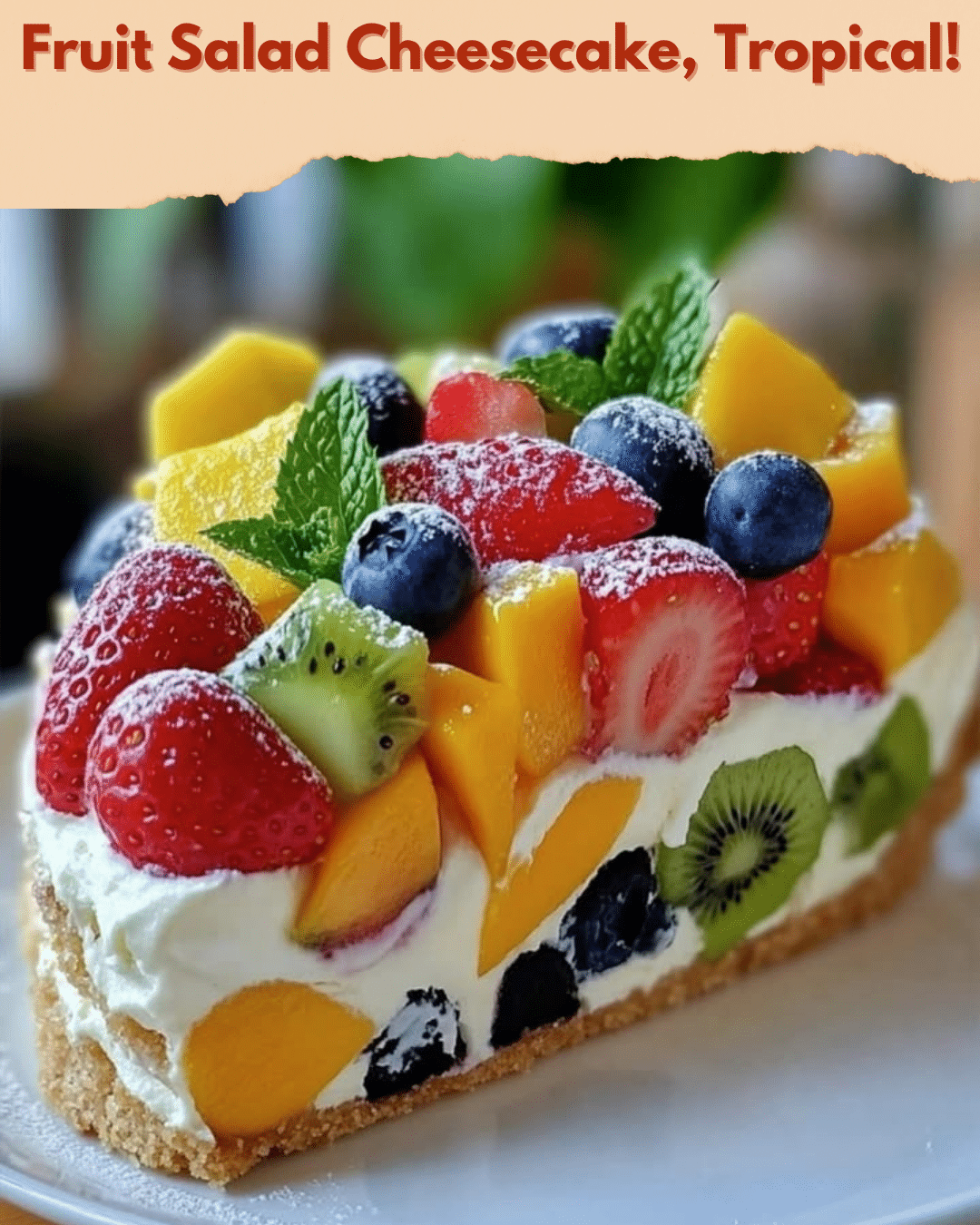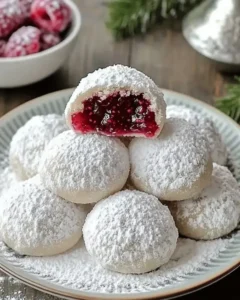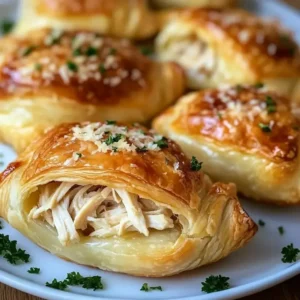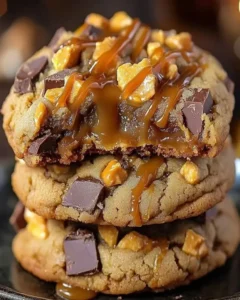Fruit Salad Cheesecake: A Tropical Delight
Dive into the exquisite blend of tropical flavors with this delightful Fruit Salad Cheesecake. This unique dessert combines the creamy richness of a cheesecake with the refreshing zest of fruit salad, creating a harmonious fusion that’s perfect for any occasion. With each bite, you’ll experience the sweet tang of exotic fruits paired with the luscious creaminess of cheesecake, making it an irresistible treat for all.
Prepare to tantalize your taste buds with this easy-to-follow Fruit Salad Cheesecake recipe. A delightful dessert that’s not only visually appealing but also brimming with flavors from the tropics. This cheesecake is adorned with a medley of vibrant fruits, boasting a burst of natural sweetness and a touch of lusciousness in every slice. If you’re a fan of tropical delights, this recipe is sure to enchant you.
Quick Recipe Highlights
- Flavor Profile: The tropical fruit salad cheesecake blends sweet and tangy notes from a variety of fresh fruits, balanced with the creamy, rich flavor of cheesecake.
- Texture: The cheesecake offers a velvety smooth texture contrasted by the refreshing juiciness of the fruit topping.
- Aroma: The aromatic experience features a medley of fresh fruit scents, complemented by subtle creamy undertones.
- Visual Appeal: Vibrant colors from a mix of fruits atop a pristine white cheesecake create an eye-catching presentation.
- Skill Level Needed: Moderate baking skills are required to balance the filling density and achieve the perfect bake.
- Special Equipment: You’ll need a springform pan and an electric mixer for best results in achieving the smooth, airy texture of the cheese filling.
Recipe Overview
- Difficulty Level: Moderately challenging, as it requires careful attention to baking the cheesecake evenly and assembling the fruit topping without ruining the presentation.
- Category: This dessert fits perfectly within the dessert category, offering a fresh take on traditional cheesecake.
- Cuisine: A fusion of classic cheesecake with a tropical twist, influenced by both Western and tropical cuisines.
- Cost: Reasonably priced, considering seasonal fruits can be cost-effective, alongside basic baking ingredients.
- Season: Best enjoyed during summer when fruits are at their peak for freshness and flavor.
- Occasion: Ideal for celebrations like birthdays, summer parties, or family gatherings where a show-stopping dessert is apt.
Why You’ll Love This Recipe
The taste combines the creaminess of traditional cheesecake with the vibrant flavors and textures of fresh tropical fruits. The mild tanginess of the cheesecake pairs beautifully with the natural sweetness in the fruits, providing a balanced palate experience.
One of the key benefits of this recipe is its simplicity. While it looks intricate, the preparation is straightforward, making it perfect for both novice and experienced bakers. The step-by-step guide ensures foolproof results, eliminating any unnecessary complexity.
This Fruit Salad Cheesecake offers a healthier alternative to traditional desserts by leveraging the natural sweetness and nutrients found in fresh fruits. Fruits like mango, pineapple, and kiwi provide essential vitamins and minerals that enhance the nutritional profile of this dessert.
Socially, presenting this cheesecake is sure to impress guests with its stunning visual appeal and delightful flavors. It’s a conversation starter that adds a gourmet touch to gatherings without requiring elaborate baking skills.
Cost-effectiveness comes from using in-season fruits, which are both economical and at their freshest. The basic components of cheesecake mean you’re not investing in costly ingredients, yet still producing a dessert with high-end appeal.
Historical Background and Cultural Significance
Cheesecake is believed to have ancient origins dating back to Greek antiquity, where athletes consumed it for energy. Over centuries, the recipe evolved, adapting new ingredients and techniques as it spread across Europe and America.
In terms of cultural importance, cheesecakes are a popular choice for celebrations and gatherings, symbolizing indulgence and hospitality in various cultures around the world.
The tropical fruit adaptation of this classic dessert draws inspiration from regions abundant with exotic fruits. As global influences increased, incorporating local produce like mangoes and pineapples became an innovative way to create diverse flavor profiles.
Several regions have introduced variations based on available local fruits, contributing unique takes on the beloved cheesecake. This evolution highlights the adaptability of cheesecake to incorporate diverse culinary traditions.
Ingredient Deep Dive
Mangoes are a staple in many tropical regions and heralded as the “king of fruits.” Historically, they hold cultural and religious significance in countries like India. Nutritionally, mangoes are rich in vitamins A and C, boosting your immune response.
When selecting mangoes, choose those that yield slightly to pressure and have a sweet aroma. For maximum freshness, store them at room temperature until fully ripe, then refrigerate. Frozen mango pulp is a viable substitute if fresh ones are unavailable.
Pineapples, first discovered by Europeans in Guadalupe, are a symbol of hospitality. Known for their digestive benefits due to the enzyme bromelain, pineapples are also high in vitamin C, providing antioxidant benefits.
Select pineapples with a firm shell and sweet scent—that’s an indicator of ripeness. Store whole pineapples in the refrigerator for longer shelf life. If needed, canned pineapple slices can substitute fresh ones, but be sure to drain them well.
Common Mistakes to Avoid
- Overmixing the cheesecake filling can incorporate too much air, leading to cracks. Mix until smooth and well incorporated.
- Failing to properly chill the cheesecake can result in a runny texture. Ensure ample chilling time for best results.
- Using low-fat cream cheese can alter the creamy texture and flavor. Opt for full-fat varieties for optimal taste.
- Adding fruits too early can cause sogginess. Wait until serving time to top the cheesecake.
- Not preparing the springform pan correctly can lead to sticking. Line it with parchment for easy removal.
- Skipping the water bath can cause uneven baking. Ensure the cheesecake bakes evenly by using this method.
- Neglecting to pre-bake the crust might result in a soggy base. Pre-bake to add stability and flavor.
- Cutting the cheesecake before it sets can lead to a messy presentation. Allow proper setting time.
- Storing in the wrong container can lead to drying out. Use an airtight container for storage.
- Using out-of-season fruits might result in flavor imbalance, so choose seasonal produce for best taste.
Essential Techniques
A successful water bath is crucial in creating a moist, crack-free cheesecake. It provides gentle and uniform heating, preventing sudden temperature shifts, which can cause cracks. Master this technique by wrapping the springform pan securely in foil to avoid water seeping in, and use a large roasting pan to ensure even heat distribution.
Mastering fruit slicing and presentation enhances the cheesecake’s visual appeal. Uniform slices of fruit not only look elegant but also ensure even flavor distribution. Use a sharp knife for clean cuts, and arrange the fruit in concentric patterns for a classic, attractive presentation.
Pro Tips for Perfect Fruit Salad Cheesecake
Let the cream cheese come to room temperature before mixing to achieve a smoother filling. This makes it easier to blend without overmixing.
To avoid cracking, don’t overbake the cheesecake. Its center should slightly jiggle when done, as it will continue setting while cooling.
Refrigerate the cheesecake uncovered initially to allow any trapped steam to escape, preventing a soggy texture.
For a glossy finish, brush the fruit topping with a thin layer of apricot jam warmed up. It enhances shine and adds a hint of sweetness.
Add a splash of lemon juice to the cheesecake filling to enhance the natural fruit flavors in the topping and balance creaminess with acidity.
Instead of graham crackers, experiment with coconut-flavored biscuits for the crust for a tropical twist.
Variations and Adaptations
Regional variations might include using locally sourced berries or even tropical flowers as garnishes. This infusion of local flavors provides a unique twist.
Seasonal adaptations can be made by swapping out fruits with those that align more with the time of year. Winter fruits like pears and apples can be used for a more festive take.
For dietary modifications, consider using a gluten-free crust alternative made from nuts and seeds, offering a healthier and allergy-friendly version.
Flavor variations can include experimenting with different fruit purees to infuse the cheesecake with various flavors, such as strawberry or passionfruit.
Texture modifications can be achieved by incorporating soft chunks of fruit within the cheese layer, providing a delightful surprise in every bite.
Experiment with presentation alternatives by serving individual portions in mason jars or mini tarts, perfect for single servings and an elegant touch at gatherings.
Serving and Presentation Guide
For beautiful plating, slice the cheesecake with a long, sharp knife, cleaning the blade with a damp towel between cuts for sharp, clean edges.
Garnishing ideas include edible flowers, mint leaves, or a light dusting of powdered sugar for an elegant finish.
Traditionally, this cheesecake is accompanied by a fruit coulis or sauce that complements and enhances the fresh fruit flavors.
For modern serving suggestions, consider deconstructing the cheesecake into layered parfaits, offering a sophisticated alternative.
Serve the cheesecake slightly chilled to ensure the dessert maintains its structure while providing a refreshingly cool experience.
Portion control tips include serving smaller slices as the richness of the dish is balanced by the lightness and freshness of the fruit.
Wine and Beverage Pairing
Complement this cheesecake with a light, fruity white wine such as a Moscato or Sauvignon Blanc, which enhances tropical fruit flavors.
For non-alcoholic alternatives, a fresh tropical fruit punch or iced herbal tea offers a refreshing accompaniment.
If coffee or tea pairs better with your palate, consider a subtly flavored green tea, providing a calming balance to the cheesecake’s rich flavors.
Maintain the beverages slightly chilled or at room temperature for optimal taste experience, avoiding extremes that might mask the flavors.
Serve wines and teas in clear glasses to maintain the visual appeal, allowing guests to appreciate the aromatic elements enhancing the dessert.
Storage and Shelf Life
For optimal storage, wrap the cheesecake well with plastic wrap to prevent it from drying out and absorbing fridge odors.
Store the cheesecake in a cool, dry part of the refrigerator, maintaining a steady temperature to ensure maximum freshness.
Use airtight containers when storing separate portions to extend shelf life and protect from outside elements.
Signs of spoilage include noticeable changes in texture, such as drying or a sour smell, indicating it’s time to discard the dessert.
When reheating the cheesecake, opt for a quick microwaving to soften the texture slightly—though it’s best enjoyed chilled.
If you’re considering freezing, slice the cheesecake first and wrap each portion individually. This method offers quick, easy access to single servings without compromising on quality.
Make Ahead Strategies
Plan your prep timeline in advance, allowing ample time for the cheesecake to set overnight before serving.
Store different layers separately before assembly, such as keeping the fruit topping and cheesecake base distinct to maintain freshness.
Assess quality impact by checking each element’s readiness before final assembly, ensuring maximum flavor preservation.
While assembling, layer the fruit topping just before serving to prevent it from soaking into the cheesecake.
Guidelines for reheating focus on ensuring that each cheesecake slice warms evenly, but note that the taste and texture are best served cold.
For added freshness, prepare a small batch of fruit topping to add right before serving, emphasizing the cheesecake’s vibrant, fresh appeal.
Scaling Instructions
To halve the recipe, adjust the ingredient quantities accordingly while maintaining ratios for consistent results and ensure the cheesecake bakes properly.
Doubling or tripling the recipe requires scaling ingredients precisely and may necessitate larger equipment, like a bigger springform pan.
Equipment adjustments might include using a larger mixing bowl or additional baking pans to accommodate increased quantities uniformly.
Modify baking times slightly when scaling to ensure even cooking – larger cheesecakes will require additional time to bake through.
Consider storage options when making larger batches; packed tightly, they last just as long as single-serving cheesecakes if stored correctly.
Nutritional Deep Dive
Explore the macro breakdown of this Fruit Salad Cheesecake, which blends carbohydrates from the crust and fruits with protein and fats from the cream cheese.
A micronutrient analysis reveals valuable vitamins from the fruit topping, like vitamin C, aiding in boosted immunity.
Health benefits center around using fresh, natural ingredients rather than processed, providing a more wholesome dessert option.
Dietary considerations include mindful portion control, promoting balanced indulgence without overconsumption of sugary treats.
Detailed portion analysis ensures that each slice offers a satisfying experience without overwhelming caloric intake, making it a guilt-free enjoyment.
Weight management tips suggest enjoying the rich flavors in moderation, complemented by physical activity or a balanced diet.
Dietary Adaptations
A gluten-free version can be achieved using crust alternatives made from almond or coconut flour, eliminating traditional wheat content.
For a dairy-free adaptation, substitute soft tofu or dairy-free cream cheese alternatives to mimic the cheesecake’s creamy texture.
Making it vegan involves not only removing dairy but also substituting eggs for silken tofu or a flaxseed mix, yielding a similar consistency.
Low-carb enthusiasts will appreciate almond flour for the crust and erythritol or stevia as low-carb sweetener substitutes.
The keto lifestyle benefits from using full-fat dairy products and low-carb crust options, making this dessert accessible yet indulgent.
Paleo versions can swap dairy ingredients for cashew or macadamia nut cheese, aligning with the dietary focus on whole, unprocessed foods.
A low-FODMAP path can be maintained by using lactose-free cream cheese and low-FODMAP-approved fruits.
Troubleshooting Guide
Address texture issues by ensuring cheesecake is thoroughly mixed without overincorporating air, leading to a dense and creamy filling instead of being too light or too thick.
For flavor balance concerns, adjust sugar and tart elements as needed, tasting the filling and fruit topping in stages for optimal results.
Temperature problems like an overly runny filling can often be remedied by chilling longer or adjusting baking times to ensure a firmer cheesecake.
If equipment challenges arise, use a hand mixer if an electric mixer is unavailable, focusing on thorough blending of all filling elements.
Ingredient substitutions should be carefully considered – using alternatives like dairy-free or gluten-free options without compromising structural integrity.
Timing concerns, such as rushing the chilling process, can be mitigated by preparing parts of the cheesecake in advance, allowing each layer adequate setting time.
Recipe Success Stories
This Fruit Salad Cheesecake has garnered accolades from the community for its innovative flavor amalgamations and simplicity in execution. Readers appreciate the fusion of classic and tropical elements creating a culinary journey.
Successful variations have included personalized toppings reflecting seasonal fruit trends and potential garnishes for unique, personal touches synonymous with reader submissions.
Adaptation stories focus on dietary transitions, where plant-based or gluten-free enthusiasts find equally enjoyable alternatives maintaining flavor integrity without excess effort.
Reader suggestions for alternative flavor pairings and equipment hacks have enriched the recipe, promoting engagement and community creativity.
Photography tips from readers include capturing the vibrant colors of the fruit topping in natural or well-lit environments to enhance the cheesecake’s visual appeal.
Frequently Asked Questions
How can I prevent my cheesecake from cracking?
Ensuring your cheesecake doesn’t crack involves incorporating steps like baking it with a water bath to provide even heat and avoiding overmixing. Another tactic is to let the cheesecake cool in the oven with the door slightly open after baking.
Can I use canned fruits instead of fresh fruits?
While fresh fruits are best for natural sweetness and texture, canned fruits can be a convenient alternative. Ensure that canned fruits are well-drained, and consider using options packed in water or natural juices to avoid adding extra sweetness.
What’s a good substitute for graham cracker crust?
Several alternatives exist, such as crushed digestive biscuits, coconut cookies, or even almond flour combined with butter for a nutty base suitable for various dietary needs.
Is it okay to freeze the cheesecake?
Freezing your cheesecake can extend its shelf life while preserving its flavors. For best results, freeze the cheesecake whole or in slices, wrapped securely to prevent freezer burn and preserve texture.
How do I fix a runny cheesecake filling?
Should your cheesecake filling seem runny, attempt chilling it further before serving. If problems persist during preparation, add a bit more gelatin or some whipped cream to stabilize the mixture.
What’s the best way to store leftovers?
Storing leftovers involves wrapping tightly in plastic or using an airtight container to maintain freshness and prevent drying. Keep in the fridge and consume within 3-4 days for optimal flavor retention.
Why does my cheesecake taste grainy?
A grainy texture typically indicates the sugar or other ingredients hadn’t fully dissolved or integrated. Ensure ingredients are at room temperature for easier blending and a smoother finish.
How can I make a lighter version of this cheesecake?
For a lighter version, substitute full-fat cream cheese with the lighter variety or use a combination of Greek yogurt for added creaminess without extra calories. Be cautious of altering taste and texture with these substitutes.
Can I use a non-dairy cheese alternative?
Yes, non-dairy alternatives like cashew or vegan cream cheese work effectively. Test for taste adjustments with these substitutes to maintain balance, given their slightly different flavor profiles.
Why does my fruit topping slide off the cheesecake?
If the topping slides, ensure the cheesecake is adequately set and the fruits have been patted dry before placement. Additionally, a thin layer of jam or gel can help bind the topping to the set cheesecake.
Additional Resources
Expand your dessert repertoire by exploring related recipes featuring alternate cheesecake inspirations from around the world, offering unique garnishing options and tropical variations.
Technique guides illuminate essential skills for achieving the perfect cheesecake consistency, providing visual aids to enhance understanding and mastering of core techniques.
Further ingredient information demystifies less-known tropical fruits and their unique flavor profiles, alongside storage and selection tips to incorporate them efficiently.
Curated lists of recommended equipment ensure quality baking results, presenting both budget-friendly and premium options to suit varying levels of culinary investment.
Seasonal variations in fruits challenge creativity, inviting exploration of new pairings and encouraging local produce incorporation for fresh, innovative desserts.
Print
Fruit Salad Cheesecake, Tropical!
Description
A delightful tropical twist on the classic cheesecake, combining the creaminess of cheesecake with the refreshing flavors of a fruit salad.
Ingredients
For the Crust:
- 1 1/2 cups graham cracker crumbs
- 1/4 cup melted butter
- 1/2 cup sugar
- 2 packages (8 oz each) cream cheese, softened
- 1 teaspoon vanilla extract
- 2 large eggs
- 1 cup mixed tropical fruits (pineapple, mango, kiwi, and papaya), diced
- 1/4 cup shredded coconut
Instructions
1. Prepare the Crust:
- Preheat your oven to 325°F (163°C).
- Mix the graham cracker crumbs and melted butter in a bowl, then press the mixture into the bottom of a 9-inch springform pan to form the crust.
- In another bowl, beat the cream cheese and sugar until smooth, then add the vanilla extract and eggs, and blend until creamy.
- Pour the cheesecake mixture over the crust.
- Bake in the preheated oven for 25-30 minutes or until the center is set.
- Allow the cheesecake to cool to room temperature, then chill in the refrigerator for at least 3 hours.
- Before serving, top the cheesecake with the mixed tropical fruits and sprinkle with shredded coconut.
Notes
You can customize the seasonings to taste.





